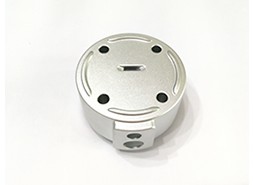The Top 7 CNC Machining Techniques
The top 7 forms of CNC machining drive the development of method of metal components and parts during the manufacturing process in the industry.
With the rise in technology, machining techniques have evolved over time. While many conventional and modern techniques are in the effective uses, CNC still remains as one of the most effective and popular machining techniques of choice as opposed to other techniques. CNC prototyping also becomes far more effective in machining design under the use of machining techniques.
1. Turning
What is termed as one of the first machining operations in the machining history, turning is a relatively simple yet an effective technique of machining. The basic working principle of turning involves clamping a workpiece over a rotating axle and turning it rapidly against a cutting tool. The cutting tool is set to be of more hardness as compared to the workpiece. Turning is an ideal operation in removing a large amount of material in relatively less time, therefore, making it an ideal technique to be used in rapid prototyping. Machining aluminum involves ‘turning’ quite often. Drilling bits can also be mounted which can be used to drill high precision holes in a workpiece.
Turning lies in the subtractive machining spectrum as the material is removed from the workpiece. Turning is an effective technique if the prototypes manufactured are in low volume.
2. Milling
The main difference that distinguishes milling from turning is that where the workpiece is rotated in turning, the cutting tool is moved in the milling process. The workpiece is usually held in a horizontal position where the cutting tool has the ability to move in all the X.Y and Z directions. Milling is ideal for removing material over the workpiece for complex and asymmetrical parts. Once milling aluminum or any other metal, cutting fluid is added in order to cool down the cutting tool. The cutting fluid also helps in the flushing of the chipped off metal as well as providing essential lubrication for the operation. In order to cool down the cutting tool. The cutting fluid also helps in the flushing of the chipped off metal as well as providing essential lubrication for the operation. Virtually, almost every type of material can be drilled or milled via CNC machine, however, This technique is mostly used for metal workpieces.
3. Surface Grinding
Surface grinding is an important CNC machining technique that is used in order to provide a precise and accurate flat surface smoothing over a metal. Any given machined Aluminum available in the market today has to undergo the surface grinding process in order to get a smooth outer flat finish. Under surface grinding, the workpiece is usually moved to and for under a grinder rotating on a fixed axle. The workpiece can be held in place in either of the two ways. If the workpiece is ferromagnetic, they are usually held by magnetic chunk. If the non-ferromagnetic workpiece is being surfaced ground, they are held by mechanical means or in some cases by vacuum.
The grinder used in this process is a spinning disk covered in abrasive grit. The coarseness of each grinder varies. The abrasiveness of the grinder depends on the type of the material needed to be ground. Silicon carbide, diamond, Aluminum oxide and cubic boron nitride (CBN) are the most commonly used abrasive materials for the grinder. In order to protect the grinder from overheating, grinding dressers are used.
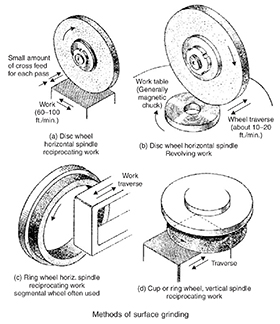
4. Cylindrical Grinding
Cylindrical grinding is a combo of turning and surface grinding. Unlike surface grinding, the workpiece is held in a stationary position where the cutting tool (cylindrical or circular grinding wheel) rotates around the workpiece. Cylindrical grinding can be done on the inside and the outside diameters of the workpiece.
Outside Diameter Cylindrical Grinding
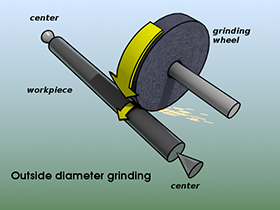
Inside Diameter Cylindrical Grinding
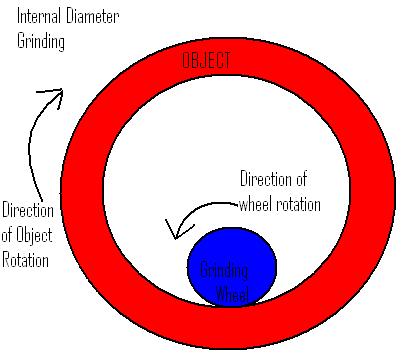
5. Wire EDM
One of the highly precise CNC machining techniques is the Wire EDM (Electrical discharge machining). Wire EDM is also referred to as spark machining, die sinking and wire erosion method. Wire EDM makes use of either copper or brass wire with a high-voltage electric charge running through it. Each operation of wire EDM involves a new copper/brass wire as it is rapidly degraded and eroded during the cutting process. Wire EDM can precisely cut highly complex designs out of many different metals. A highly complex machined Aluminum is likely to be machined via Wire EDM since conventional techniques do not attain the high precision and accuracy that wire EDM do. Wire EDM however, cannot work over blind spots.
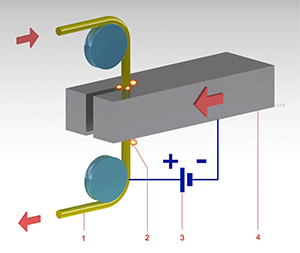
1 Wire. 2 Electrical discharge erosion (Electric arc). 3 Electrical potential. 4 Workpiece.
6. Solid Sink EDM
In the solid sink EDM, the conductive electrode is placed in close proximity to the workpiece while it is constantly supplied with dielectric fluid. The electrode is precisely shaped according to the shape that is needed to be made out of the workpiece. As the current is passed through the electrodes, the discharging electrodes force the metal particles off the surface of the workpiece. Solid Sink EDM uses of graphite, copper tungsten, or pure copper electrodes for the operation. The discharging of the electrodes makes them be replaced over time though they do not touch the workpiece itself. Solid sink EDM is ideal to make holes, pockets or square features inside a hardened workpiece. High-end aluminum machining includes solid sink EDM as a fast and effective way to make holes and complex geometry.
7. Optical Grinding
Optical grinding is a useful CNC machining technique once it comes to plastic and glass optics. Since optics require very fine surfaces with very close tolerances, specialized grinding equipment is implemented which rotates a grinding wheel swiftly against the optic material on multiple axes. For optical grinding, grinding paste is used as the lubricant as well as to provide a well-polished finish.
Case Studies
- CNC Machining
Related Tags :






